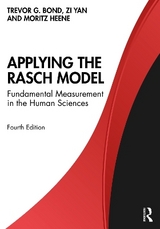
Applying the Rasch Model
Routledge (Verlag)
978-0-415-83342-4 (ISBN)
- Titel erscheint in neuer Auflage
- Artikel merken
Highlights of the new edition include:
-More learning tools to strengthen readers’ understanding including chapter introductions, boldfaced key terms, chapter summaries, activities, and suggested readings.
-Divided chapters (4, 6, 7 & 8) into basic and extended understanding sections so readers can select the level most appropriate for their needs and to provide more in-depth investigations of key topics.
-A website at www.routledge.com/9780415833424 that features free Rasch software, data sets, an Invariance worksheet, detailed instructions for key analyses, and links to related sources.
-Greater emphasis on the role of Rasch measurement as a priori in the construction of scales and its use post hoc to reveal the extent to which interval scale measurement is instantiated in existing data sets.
-Emphasizes the importance of interval level measurement data and demonstrates how Rasch measurement is used to examine measurement invariance.
-Insights from other Rasch scholars via innovative applications (Ch. 9).
-Extended discussion of invariance now reviews DIF, DPF, and anchoring (ch. 5).
-Revised Rating Scale Model material now based on the analysis of the CEAQ (ch.6).
-Clarifies the relationships between Rasch measurement, True Score Theory, and Item Response Theory by reviewing their commonalities and differences (Ch.13).
-Provides more detail on how to conduct a Rasch analysis so readers can use the techniques on their own (Appendix B).
Intended as a text for graduate courses in measurement, item response theory, (advanced) research methods or quantitative analysis taught in psychology, education, human development, business, and other social and health sciences, professionals in these areas also appreciate the book‘s accessible introduction.
Trevor G. BOND is Adjunct Professor at the College of Arts, Society and Education at James Cook University, Australia. Christine M. FOX is a Full Professor in Research and Measurement at The University of Toledo.
Foreword 1. Why Measurement Is Fundamental 2. Important Principles of Measurement Made Explicit 3. Basic Principles of the Rasch Model 4. Building a Set of Items for Measurement 5. Invariance: A Crucial Property of Scientific Measurement 6. Measurement Using Likert Scales 7. The Partial Credit Rasch Model 8. Measuring Facets Beyond Ability and Difficulty 9. Making Measures, Setting Standards & Rasch Regression 10. The Rasch Model Applied Across the Human Sciences 11. Rasch Modeling Applied: Rating Scale Design 12. Rasch Model Requirements: Model Fit and Unidimensionality 13. A Synthetic Overview Appendix A. Getting Started Appendix B. Technical Aspects of the Rasch Model
| Zusatzinfo | 65 Halftones, black and white; 68 Tables, black and white |
|---|---|
| Verlagsort | London |
| Sprache | englisch |
| Maße | 152 x 229 mm |
| Gewicht | 572 g |
| Themenwelt | Geisteswissenschaften ► Psychologie ► Test in der Psychologie |
| Studium ► Querschnittsbereiche ► Epidemiologie / Med. Biometrie | |
| Sozialwissenschaften ► Pädagogik | |
| Sozialwissenschaften ► Soziologie ► Empirische Sozialforschung | |
| ISBN-10 | 0-415-83342-6 / 0415833426 |
| ISBN-13 | 978-0-415-83342-4 / 9780415833424 |
| Zustand | Neuware |
| Informationen gemäß Produktsicherheitsverordnung (GPSR) | |
| Haben Sie eine Frage zum Produkt? |
aus dem Bereich



